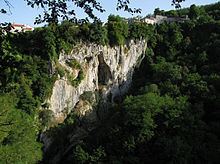 | ||
Reportage sulla foiba di lusiana vicenza 07 luglio 2011
A foiba (plural: foibas or foibe) is a type of deep natural sinkhole, doline, or sink, and is a collapsed portion of bedrock above a void. Sinks may be a sheer vertical opening into a cave, or a shallow depression of many hectares. They are common in the Kras (Carso) region, a karstic plateau region shared by Italy, Slovenia, and Croatia.
Contents
- Reportage sulla foiba di lusiana vicenza 07 luglio 2011
- La foiba di basovizza le vie della memoria
- History
- References
La foiba di basovizza le vie della memoria
History
The term "foiba" was used in the 1770s by Italian naturalist Alberto Fortis who wrote a number of books about karst of Dalmatia. It is an Italian derivative of the Latin fovea, meaning "pit" or "chasm". They are indeed chasms excavated by water erosion, have the shape of an inverted funnel, and can be up to 200 metres (660 ft) deep. Such formations number in the hundreds in Istria.
In karst areas, a sinkhole, sink, or doline is a closed depression draining underground. It can be cylindrical, conical, bowl-shaped or dish-shaped. The diameter ranges from a few to many hundreds of metres. The name "doline" comes from dolina, the Slovenian word for this very common feature. The term "foiba" may also refer to a deep wide chasm of a river at the place where it goes underground.
